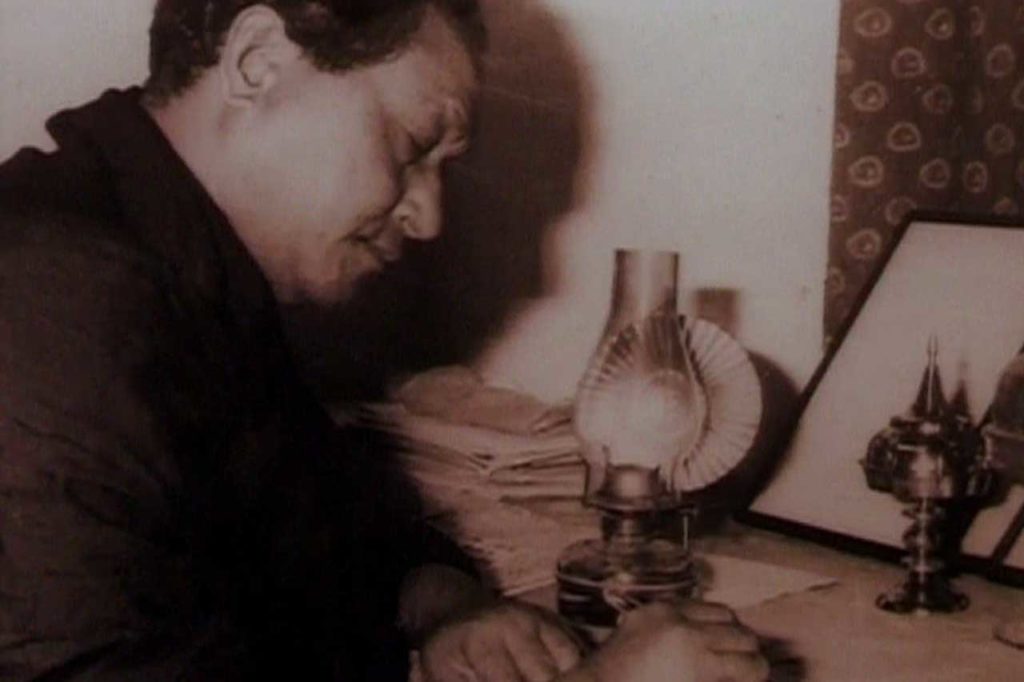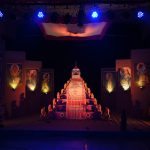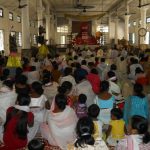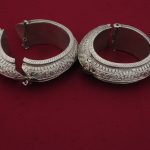Bishnu Prasad Rabha lived in a tumultuous time, when the country was at the height of freedom movement. He was an active participant in that movement. He became so serious in this struggle for freedom that he dedicated his entire life to it. He did not mean freedom to be one-dimensional; it was not freedom from the British rule alone for him. By freedom, he meant liberation from poverty and all types of hegemony as well. He renounced a huge wealth in the form of 1500 bigha land, bequeathed to him by his father Gopal Rabha in favour of the tenant farmers and went on wandering from one place to another like a nomad. He was a true organiser of the people. His service in mobilising the rural masses during the freedom movement was really matchless. Only two other stalwarts, Sankar Barua and Jyoti Prasad Agarwalla came a bit near him in this regard.
Bishnu Prasad Rabha had no dichotomy in his life. Whatever he professed, he did in his own life. Even his colleagues were not so sincere in their avowed principle. Some of them were actually casteists who interfered unashamedly in Bishnu Prasad’s personal life. But Bishnu Prasad took everything in his stride. The magnanimity showed by him to those so-called revolutionaries was divine. The common people realised it and showered love on him plentifully. There was even an instance when the public selected a bride for him and got him married to her.
Bishnu Prasad Rabha’s polity was not confined to narrow party politics. He could have acquired immense political clout in the corridors of power after the country became independent, had he only wished it. But he preferred to continue with the struggle, which for him had only started in 1947 in the real sense of the term. He did not hesitate to declare categorically that the independence acquired by the country was a shame. The common masses remained in the dark abyss of poverty like they had been before. His strong stand made him enemy of the power that be. It was only at the instance of the Tezpur citizens towards the fag end of his life that he decided to fight from within the system. By then his health had deteriorated a lot. Otherwise the politics of Assam would perhaps have taken a different turn.
Bishnu Prasad Rabha was a versatile genius. His dancing prowess mesmerised the audience. He was bestowed the title Kalaguru by Dr Sarvapalli Radhakrishnan at Varanasi following a recital of the Tandava dance there. He was the embodiment of Nataraja, the heritage of Assam. Incidentally, the concept of Nataraja was a contribution of Assam to Indian civilisation. Till date there has not been a better exponent than Bishnu Prasad of the Tandava dance. Even Uday Sankar was fascinated by his recital and wanted to learn the same from him. The concept of Tandava was as if ingrained in Bishnu Prasad. He wanted to demolish everything bad in the society, which was the message of the Tandava dance.
Bishnu Prasad Rabha was simply marvellous as an actor. The Baan theatre of Tezpur saw his genius aplenty. He ably assisted Jyoti Prasad in the making of the first ever Assamese film Joymoti. There were innumerable plays where Bishnu Prasad lent his acting prowess. He could have very well established himself as a commercial artist outside Assam since he had access to the art world in Kolkata and Mumbai. But he did not go for those green pastures as he had taken up this medium only as a tool for spreading this message. His acting talent came very handy in moving incognito around the State for freedom movement. Sometimes he sneaked out of a place cordoned by police force by posing as a police official.
Bishnu Prasad Rabha could sing very nicely. He learnt Bargeet composed by saint Srimanta Sankaradeva when he was staying at Barpeta with his sister. Everything pertaining to the saint attracted Bishnu Prasad greatly. He was not an atheist like fellow communists. He was a believer in God, whom he saw in the multitude. Of course that was the very ideal of Srimanta Sankaradeva too, who did not worship any icon and declared the enlightened devotees as the manifestation of his God. It is therefore significant that the most popular imaginary portrait of Srimanta Sankaradeva is the one drawn by Bishnu Prasad Rabha. The latter could imagine a picture of the former because he could visualise the saint. A painter has to first visualise his/her object before he/she can give shape to it. Unfortunately the commonly available portrait of Srimanta Sankaradeva drawn by Bishnu Prasad Rabha lacks graciousness of the saint in full measure; it is also devoid of the requisite atheleticism in the saint’s agile body. The better portraits drawn by him remained unavailable for the common people till the other day. These have been reproduced by his family. There are four portraits of Srimanta Sankaradeva in water colour which are simply marvellous. These pieces were pioneering attempts at drawing imaginary portraits of the saint. We have made these portraits easily available to all through website and social sites.
It was not that Bishnu Prasad Rabha just roamed around the state and indulged in performing art occasionally. He was a serious academician too. In fact he was the first anthropologist of Assam. His book Bano-Kobang is a nice work of anthropological study based on field work. The observations as well as materials compiled therein remain invaluable source of information about the ethnic groups in the State till date. This aspect of Bishnu Prasad has largely been ignored and the public get to know him only as a performing artist. This is because most of his writings were published only posthumously and even then these were ignored by the mainstream critics of Assam. There is a tendency in Assam to treat only poems, short stories and novels as literary works. It is true that those creative works left by Bishnu Prasad were a bit weak in form. But he was successful as a lyricist. And he was richer in his anthropological works. But those were never counted by our literary critics. The Asom Sahitya Sabha totally ignored Bishnu Prasad when he was alive just as they ignored Jyoti Prasad. History however never fails to do justice to a genius. Now these two ‘Prasad’s are remembered as the symbol of Assamese culture. What an irony!
Bishnu Prasad Rabha was very emphatic about the rise of the downtrodden people both in his writings and his speeches. In this respect he was like Ambikagiri Roychoudhury, who also exhorted the people to get up from slumber. But Bishnu Prasad was even more radical than Ambikagiri and never went near the Congress party. Like Sri Aurobindo he could see the inherent contradictions in Congress, a party led by the upper class people. It was because of this weakness in Congress leadership that the party always stopped short of any radical design and was almost like the British in policy matters. Ambikagiri and Jyoti Prasad failed to see that. However, that does not rob the duo of their due place in Assam history. We are only making a comparative study here with Bishnu Prasad Rabha. No such study has been done till date.
Bishnu Prasad Rabha was very conscious of his tribal lineage. He participated in several symposiums and conventions about tribal heritage. Each lecture delivered by him was a masterpiece. He highlighted the fact that the Assamese language and culture was predominantly tribal. This ran counter to the prevailing conception that Assamese language and culture was basically an Aryan one. Even Dr Banikanta Kakoti was mistaken in this regard. He opined that the Assamese language and the culture was basically an Aryan one. This view was shared by Dr Birinchi Kumar Barua, Dr Prafulla Dutta Goswami etc. But Dr Kakoti and his supporters could never explain why the caste system or for that matter many other evil traits of the Aryans were so subdued here. Bishnu Prasad Rabha’s view that Assamese culture was predominantly tribal seems to be the correct one. Srimanta Sankaradeva culled materials from different tribal dances and music to evolve new classical forms of dance and music. Unfortunately some orthodox people refused to accept that till the other day.
It is because of the basic difference of approach to cultural study that Bishnu Prasad Rabha was ignored by the so-called intelligentsia of Assam. The revival of interest in him since the last four decades is also highly motivated. First, he was resurrected as a symbol of sub-nationalism during the Assam movement and then of ‘liberation’ struggle in the early nineties. But Bishnu Prasad was very much an Indian. He encouraged the citizens of Tezpur to face the Chinese aggressors in 1962, whereupon he was taken into custody by the then government! Bishnu Prasad rather talked of the suppressed humanity, wherever he went. Thus he had some similarity with Dr Ernesto Che Guevara. The lives of the two revolutionaries also were similar to a great extent.
[Edited version of the author’s originally published article in The Assam Tribune on June 20, 2008]




